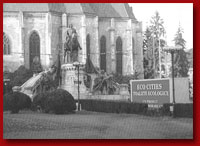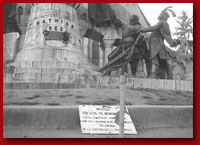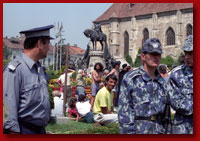 |
THE CHURCH OF ST. SAVIOUR AT THE SOURCE OF THE CETINA RIVER
Although the imposing ruins of this ninth-century church attracted the attention of travellers as early as the seventeenth century, serious excavations could not be conducted before the end of the Second World War. The local people, descendants of seventeenth-century Serbian settlers, claimed that the church was Orthodox (although it had been out of use for a long time before their arrival) and opposed excavations in the area. Several archaeologists attempting to start research in the 1980s were almost lynched by a mob.
According to legend, a legend borne of pseudo-scholarly study in the nineteenth century, the church was built by the "Orthodox Bosnian king Tvrtko" for his "Serbian subjects in the region". Paradoxically, this myth preserved the church during the 1991-1995 war in Croatia, when many other medieval churches in the region were destroyed. Intending to establish an Orthodox church, Serbian architects prepared a study in 1994 including plans to reconstruct the church and add a dome. This project was brought to a halt by the end of the war in 1995. |
|
|
 |
HERITAGE BATTLES IN CLUJ IN THE 1990S
History: Following the conquest of Dacia by the Romans and its incorporation into the Roman Empire, a Roman city was erected on the site of the old settlement of Napoca and elevated to the status of municipium by emperor Hadrian (AD 124). In the middle ages, in 1316 Cluj (Kolozsvár, Clausenburg) acquired the privilege of civitas, and in the fourteenth and fifteenth centuries it grew to become one of the primary urban centers in Transylvania, specially favored by Mathias Corvinus, King of Hungary (1458-1490), who was born in the town. This was honored in 1902 by the erection of his statue by János Fadrusz on the main square, in front of the medieval St. Michael’s Church. This statue became the symbol of the city.
In 1992 Gheorghe Funar, a politician of the far right, won the local election and became mayor of Cluj for the next twelve years. His anti-Hungarian rhetoric and acts during the campaign and in the period that followed instilled frustration in the Hungarian community of Cluj. In 1994, the mayor decided to excavate the Roman archaeological sites, which lay directly under the main square. Two important periods in the town's history—the antique and the medieval—were placed at odds with each other. The Hungarian citizens of the town poured into the streets to protect the historical monuments on the square. This demonstration started on July 2nd, 1994 and threatened to erupt in serious inter-ethnic strife. Excavations were delayed for one month. The excavation started on August 2nd with tight security in place. It soon became clear that the act of excavating had more significance than the finds themselves. As time passed, the excavation units started to cave in, and even those who had supported the investigations at the outset withdrew their support. The mayor next proposed the erection of a life-sized replica of Trajan's Column immediately next to the archaeological site. The foot stone was laid on the National Holiday, December 1st, 1999, but the town council eventually rejected the proposal. Another initiative by mayor Funar was the erection of a cca 30 meter high statue of Avram Iancu by Ilie Berindei in the vicinity if the main square, to counterbalance the image of Mathias. The main square of Cluj has remained high on the political agenda up to the present day. A solution that pleases all parties has yet to be found... |
|
 |
 |
 |
|
|
|
 |
HUNGARIAN "LEBENSRAUM" ROAD ATLAS
Instead of indicating the borders of modern Hungary this Road Atlas from 2005 shows the area of the Hungarian Kingdom before the Peace Treaty of Trianon, with all geographical names given "only in their correct, Hungarian form." It was made, among others, for "those people, who want to live and get along in their mother tongue in the regions that are at present still torn away." A car sticker in the shape of the Hungarian Kingdom is also included. |
|
 |
|